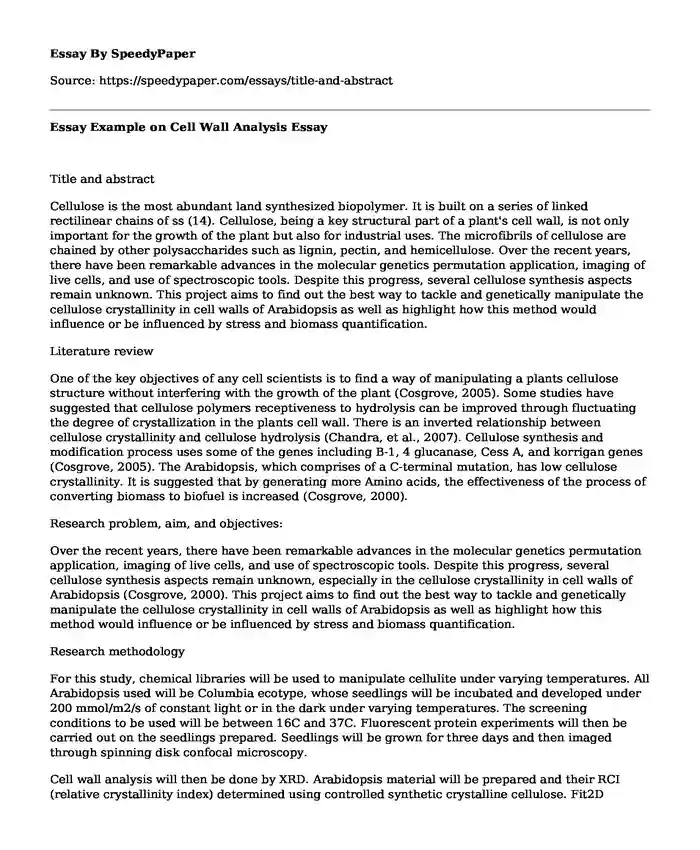Title and abstract
Cellulose is the most abundant land synthesized biopolymer. It is built on a series of linked rectilinear chains of ss (14). Cellulose, being a key structural part of a plant's cell wall, is not only important for the growth of the plant but also for industrial uses. The microfibrils of cellulose are chained by other polysaccharides such as lignin, pectin, and hemicellulose. Over the recent years, there have been remarkable advances in the molecular genetics permutation application, imaging of live cells, and use of spectroscopic tools. Despite this progress, several cellulose synthesis aspects remain unknown. This project aims to find out the best way to tackle and genetically manipulate the cellulose crystallinity in cell walls of Arabidopsis as well as highlight how this method would influence or be influenced by stress and biomass quantification.
Literature review
One of the key objectives of any cell scientists is to find a way of manipulating a plants cellulose structure without interfering with the growth of the plant (Cosgrove, 2005). Some studies have suggested that cellulose polymers receptiveness to hydrolysis can be improved through fluctuating the degree of crystallization in the plants cell wall. There is an inverted relationship between cellulose crystallinity and cellulose hydrolysis (Chandra, et al., 2007). Cellulose synthesis and modification process uses some of the genes including B-1, 4 glucanase, Cess A, and korrigan genes (Cosgrove, 2005). The Arabidopsis, which comprises of a C-terminal mutation, has low cellulose crystallinity. It is suggested that by generating more Amino acids, the effectiveness of the process of converting biomass to biofuel is increased (Cosgrove, 2000).
Research problem, aim, and objectives:
Over the recent years, there have been remarkable advances in the molecular genetics permutation application, imaging of live cells, and use of spectroscopic tools. Despite this progress, several cellulose synthesis aspects remain unknown, especially in the cellulose crystallinity in cell walls of Arabidopsis (Cosgrove, 2000). This project aims to find out the best way to tackle and genetically manipulate the cellulose crystallinity in cell walls of Arabidopsis as well as highlight how this method would influence or be influenced by stress and biomass quantification.
Research methodology
For this study, chemical libraries will be used to manipulate cellulite under varying temperatures. All Arabidopsis used will be Columbia ecotype, whose seedlings will be incubated and developed under 200 mmol/m2/s of constant light or in the dark under varying temperatures. The screening conditions to be used will be between 16C and 37C. Fluorescent protein experiments will then be carried out on the seedlings prepared. Seedlings will be grown for three days and then imaged through spinning disk confocal microscopy.
Cell wall analysis will then be done by XRD. Arabidopsis material will be prepared and their RCI (relative crystallinity index) determined using controlled synthetic crystalline cellulose. Fit2D software will be used to incorporate the data collected, and Scherrer equation analyzed using fitting a Gauss peak.
Impact of their research studies
The fiber crop stem is a good example of naturally occurring contrasting lignification pattern that exist in the same element. This composition allows the use of these stems lignocellulosic biomass for various industrial applications (Wu, Joshi, & Chiang, 2000). Although some recent studies have uncovered ways of regulating the various lignification synopses in such plants, an integrative analysis of the best way to tackle and genetically manipulate the cellulose crystallinity in cell walls of Arabidopsis and the effects of stress and biomass quantification on the method is still missing.
To completely understand the engagements that are conscientious for the biogenesis of the fiber crops cell wall, it is essential to integrate varying throughputs with precise experimental design, co-visualizations, and bioinformatics tools. The cohesive knowledge that is acquired can be used to modify the metabolism of the cell wall, which can be then used to improve the process of fibers extraction
References
Chandra, R. P., Bura, R., Mabee, W. E., Berlin, D. A., Pan, X., & Saddler, J. N. (2007). Substrate pretreatment: The key to effective enzymatic hydrolysis of lignocellulosics?. In Biofuels (pp. 67-93). Springer Berlin Heidelberg.
Arpat, A., Waugh, M., Sullivan, J. P., Gonzales, M., Frisch, D., Main, D., ... & Wilkins, T. (2004). Functional genomics of cell elongation in developing cotton fibers. Plant molecular biology, 54(6), 911-929.
Northcote, D. H. (1972). Chemistry of the plant cell wall. Annual review of plant physiology, 23(1), 113-132.
Cosgrove, D. J. (2000). Loosening of plant cell walls by expansins. Nature,407(6802), 321-326.
Cosgrove, D. J. (2005). Growth of the plant cell wall. Nature reviews molecular cell biology, 6(11), 850-861.
Wu, L., Joshi, C. P., & Chiang, V. L. (2000). A xylemspecific cellulose synthase gene from aspen (Populus tremuloides) is responsive to mechanical stress. The Plant Journal, 22(6), 495-502.
Cite this page
Essay Example on Cell Wall Analysis. (2019, Jun 03). Retrieved from https://speedypaper.net/essays/title-and-abstract
Request Removal
If you are the original author of this essay and no longer wish to have it published on the SpeedyPaper website, please click below to request its removal:
- Budgeting Essay Sample for Your Free Use
- Free Essay: Impact of Musical Interventions on Language and Cognitive Development
- When Is A Drug Not A Drug - Article Review Essay Sample
- Free Essay with a Literature Review on Privatization and Municipality
- Rationale Essay for a Degree Program in Business Management and Economics
- The Housing Bubble and Housing Crisis in Vancouver - Essay Sample
- Essay Sample on Visual Campaign to Deliver a Global Message
Popular categories





